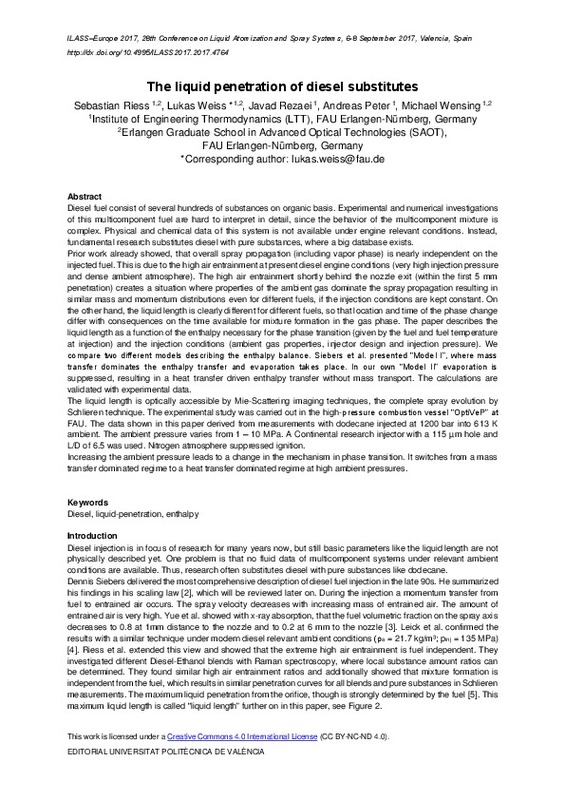JavaScript is disabled for your browser. Some features of this site may not work without it.
Buscar en RiuNet
Listar
Mi cuenta
Estadísticas
Ayuda RiuNet
Admin. UPV
The liquid penetration of diesel substitutes
Mostrar el registro sencillo del ítem
Ficheros en el ítem
| dc.contributor.author | Riess, Sebastian
|
es_ES |
| dc.contributor.author | Weiss, Lukas
|
es_ES |
| dc.contributor.author | Rezaei, Javad
|
es_ES |
| dc.contributor.author | Peter, Andreas
|
es_ES |
| dc.contributor.author | Wensing, Michael
|
es_ES |
| dc.date.accessioned | 2018-03-29T10:31:02Z | |
| dc.date.available | 2018-03-29T10:31:02Z | |
| dc.date.issued | 2017-07-28 | |
| dc.identifier.isbn | 9788490485804 | |
| dc.identifier.uri | http://hdl.handle.net/10251/99932 | |
| dc.description.abstract | [EN] Diesel fuel consist of several hundreds of substances on organic basis. Experimental and numerical investigations of this multicomponent fuel are hard to interpret in detail, since the behavior of the multicomponent mixture is complex. Physical and chemical data of this system is not available under engine relevant conditions. Instead, fundamental research substitutes diesel with pure substances, where a big database exists. Prior work already showed, that overall spray propagation (including vapor phase) is nearly independent on the injected fuel. This is due to the high air entrainment at present diesel engine conditions (very high injection pressure and dense ambient atmosphere). The high air entrainment shortly behind the nozzle exit (within the first 5 mm penetration) creates a situation where properties of the ambient gas dominate the spray propagation resulting in similar mass and momentum distributions even for different fuels, if the injection conditions are kept constant. On the other hand, the liquid length is clearly different for different fuels, so that location and time of the phase change differ with consequences on the time available for mixture formation in the gas phase. The paper describes the liquid length as a function of the enthalpy necessary for the phase transition (given by the fuel and fuel temperature at injection) and the injection conditions (ambient gas properties, injector design and injection pressure). We compare two different models describing the enthalpy balance. Siebers et al. presented “Model I”, where mass transfer dominates the enthalpy transfer and evaporation takes place. In our own “Model II” evaporation is suppressed, resulting in a heat transfer driven enthalpy transfer without mass transport. The calculations are validated with experimental data. The liquid length is optically accessible by Mie-Scattering imaging techniques, the complete spray evolution by Schlieren technique. The experimental study was carried out in the high-pressure combustion vessel “OptiVeP” at FAU. The data shown in this paper derived from measurements with dodecane injected at 1200 bar into 613 K ambient. The ambient pressure varies from 1 – 10 MPa. A Continental research injector with a 115 µm hole and L/D of 6.5 was used. Nitrogen atmosphere suppressed ignition. Increasing the ambient pressure leads to a change in the mechanism in phase transition. It switches from a mass transfer dominated regime to a heat transfer dominated regime at high ambient pressures. | es_ES |
| dc.format.extent | 8 | es_ES |
| dc.language | Inglés | es_ES |
| dc.publisher | Editorial Universitat Politècnica de València | es_ES |
| dc.relation.ispartof | Ilass Europe. 28th european conference on Liquid Atomization and Spray Systems | es_ES |
| dc.rights | Reconocimiento - No comercial - Sin obra derivada (by-nc-nd) | es_ES |
| dc.subject | Diesel | es_ES |
| dc.subject | Liquid-penetration | es_ES |
| dc.subject | Enthalpy | es_ES |
| dc.title | The liquid penetration of diesel substitutes | es_ES |
| dc.type | Capítulo de libro | es_ES |
| dc.type | Comunicación en congreso | es_ES |
| dc.identifier.doi | 10.4995/ILASS2017.2017.4764 | |
| dc.relation.projectID | info:eu-repo/grantAgreement/EC/H2020/675528/EU/Effect of 4500bar injection pressure and super-critical phase change of surrogate and real-world fuels enriched with additives and powering Diesel engines on soot emissions reduction/ | |
| dc.rights.accessRights | Abierto | es_ES |
| dc.description.bibliographicCitation | Riess, S.; Weiss, L.; Rezaei, J.; Peter, A.; Wensing, M. (2017). The liquid penetration of diesel substitutes. En Ilass Europe. 28th european conference on Liquid Atomization and Spray Systems. Editorial Universitat Politècnica de València. 1060-113. https://doi.org/10.4995/ILASS2017.2017.4764 | es_ES |
| dc.description.accrualMethod | OCS | es_ES |
| dc.relation.conferencename | ILASS2017 - 28th European Conference on Liquid Atomization and Spray Systems | es_ES |
| dc.relation.conferencedate | September 06-08,2017 | es_ES |
| dc.relation.conferenceplace | Valencia, Spain | es_ES |
| dc.relation.publisherversion | http://ocs.editorial.upv.es/index.php/ILASS/ILASS2017/paper/view/4764 | es_ES |
| dc.description.upvformatpinicio | 1060 | es_ES |
| dc.description.upvformatpfin | 113 | es_ES |
| dc.type.version | info:eu-repo/semantics/publishedVersion | es_ES |
| dc.relation.pasarela | OCS\4764 | es_ES |








